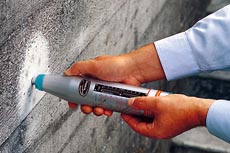
Schmidt hammer
Encyclopedia
A Schmidt hammer, also known as a Swiss hammer or a rebound hammer, is a device to measure the elastic
properties or strength of concrete
or rock
, mainly surface hardness and penetration resistance.
 It was invented by Ernst Schmidt, a Swiss engineer.
It was invented by Ernst Schmidt, a Swiss engineer.
The hammer measures the rebound of a spring-loaded mass impacting against the surface of the sample. The test hammer will hit the concrete at a defined energy. Its rebound is dependent on the hardness of the concrete and is measured by the test equipment. By reference to the conversion chart, the rebound value can be used to determine the compressive strength
.
When conducting the test the hammer should be held at right angles to the surface which in turn should be flat and smooth. The rebound reading will be affected by the orientation of the hammer, when used in a vertical position (on the underside of a suspended slab for example) gravity will increase the rebound distance of the mass and vice versa for a test conducted on a floor slab. The Schmidt hammer is an arbitrary scale ranging from 10 to 100. Schmidt hammers are available from their original manufacturers in several different energy ranges. These include: (i) Type L-0.735 Nm impact energy, (ii) Type N-2.207 Nm impact energy; and (iii) Type M-29.43 Nm impact energy.
The test is also sensitive to other factors:
Prior to testing, the Schmidt hammer should be calibrated using a calibration test anvil supplied by the manufacturer for that purpose. 12 readings should be taken, dropping the highest and lowest, and then take the average of the ten remaining.
Using this method of testing is classed as indirect as it does not give a direct measurement of the strength of the material. It simply gives an indication based on surface properties, it is only suitable for making comparisons between samples.
This test method for testing concrete is governed by ASTM C805. ASTM D5873 describes the procedure for testing of rock.
Solid mechanics
Solid mechanics is the branch of mechanics, physics, and mathematics that concerns the behavior of solid matter under external actions . It is part of a broader study known as continuum mechanics. One of the most common practical applications of solid mechanics is the Euler-Bernoulli beam equation...
properties or strength of concrete
Concrete
Concrete is a composite construction material, composed of cement and other cementitious materials such as fly ash and slag cement, aggregate , water and chemical admixtures.The word concrete comes from the Latin word...
or rock
Rock (geology)
In geology, rock or stone is a naturally occurring solid aggregate of minerals and/or mineraloids.The Earth's outer solid layer, the lithosphere, is made of rock. In general rocks are of three types, namely, igneous, sedimentary, and metamorphic...
, mainly surface hardness and penetration resistance.

The hammer measures the rebound of a spring-loaded mass impacting against the surface of the sample. The test hammer will hit the concrete at a defined energy. Its rebound is dependent on the hardness of the concrete and is measured by the test equipment. By reference to the conversion chart, the rebound value can be used to determine the compressive strength
Compressive strength
Compressive strength is the capacity of a material or structure to withstand axially directed pushing forces. When the limit of compressive strength is reached, materials are crushed. Concrete can be made to have high compressive strength, e.g...
.
When conducting the test the hammer should be held at right angles to the surface which in turn should be flat and smooth. The rebound reading will be affected by the orientation of the hammer, when used in a vertical position (on the underside of a suspended slab for example) gravity will increase the rebound distance of the mass and vice versa for a test conducted on a floor slab. The Schmidt hammer is an arbitrary scale ranging from 10 to 100. Schmidt hammers are available from their original manufacturers in several different energy ranges. These include: (i) Type L-0.735 Nm impact energy, (ii) Type N-2.207 Nm impact energy; and (iii) Type M-29.43 Nm impact energy.
The test is also sensitive to other factors:
- Local variation in the sample. To minimize this it is recommended to take a selection of readings and take an average value.
- Water content of the sample, a saturated material will give different results from a dry one.
Prior to testing, the Schmidt hammer should be calibrated using a calibration test anvil supplied by the manufacturer for that purpose. 12 readings should be taken, dropping the highest and lowest, and then take the average of the ten remaining.
Using this method of testing is classed as indirect as it does not give a direct measurement of the strength of the material. It simply gives an indication based on surface properties, it is only suitable for making comparisons between samples.
This test method for testing concrete is governed by ASTM C805. ASTM D5873 describes the procedure for testing of rock.

